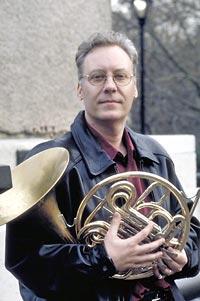Tom Varner swings the French horn

Tom Varner compares playing jazz on French horn to "doing a beautiful ballet in your socks — on ice."
Widely recognized as the best on his instrument, Varner recently joined the growing ranks of New York jazz émigrés to the Emerald City.
Varner performed his first concert as a leader here Sunday for a modest but rapt audience at Tula's.
At 5 p.m. Thursday, Varner performs with his trio — Greg Campbell, drums; Eric Barber, reeds — in the Fuller Garden Court at the Seattle Asian Art Museum (free with museum admission, $3-$5; 206-654-3100 or www.seattleartmuseum.org).
Firmly established in Upper Manhattan for 26 years, Varner moved to Seattle when his wife, Terri Constant, a University of Washington alum raised here and in Kirkland, was hired as the Seattle Public Library's new Web manager.
It was a good time for a move, says the 49-year-old horn player, as the couple contemplated the prospect of raising two children — ages 3 and 5 — in New York.
"I'm amazed at the easiness of life here," he said. "It took us 20 minutes to sign Jack up [for school]. The buses stop for you if you're halfway down the block. And everything is so spotless!"
Needless to say, Varner has spent most of his life on the East Coast.
He grew up in New Jersey, studied at Oberlin and the New England Conservatory in Boston, then moved to New York, where he earned a reputation as both a postmodern explorer and a swinging jazz improviser.
A classical French horn player since the age of 9, Varner got the jazz bug in high school. Inspired by Julius Watkins, a horn player who had worked with Quincy Jones, Varner asked his band director if he could transpose trombone parts in the school jazz band.
"When I look back at it, I shake my head," said Varner. "What was I thinking? I could have switched to trumpet."
The French horn is not a user-friendly instrument.
"It's very slippery," he said. "Because it's such a long piece of tubing — 20 to 30 feet, depending on the instrument — you can pretty much push any one of the valves and any note will come out. It's all with the lip, basically. But in jazz, sometimes slipping and sliding is good. I found I could make music out of the mistakes. I think that's partly what attracted me to jazz."
Varner is too modest. He may smear and burble notes for effect, but he also can flat-out play jack-rabbit bebop, with precise articulation and a bluesy swing feel.
He has been recognized for his efforts, consistently placing or winning polls and receiving four-star reviews in jazz magazines.
One of his most beautiful albums, the Americana tableau "The Window Up Above" (1998, New World), explores songs of the Civil War era in a chamber/folk context. "Second Communion" (Omnitone, 2001) is a brilliant biographical homage to the late, great trumpet player and composer Don Cherry.
The more formally experimental "Swimming" (Omnitone, 1999) features "Pantoum," a composition based on one of those puzzlelike paradigms favored by the Provencal poets.
"I think of myself as a maximalist," said Varner of his eclecticism. "At Tula's, we played some of my more postmodern pieces, but then we also played 'Memories of You' and 'The Man I Love.' I try to combine the entire tradition honestly, with clarity and intelligence and passion. But nonforced passion. I hate "JAZZ!!!" but I love 'jazz.' "
Because SAAM is so acoustically "live," the performance there will probably lean toward quietly exploratory, interactive free-improv, though Varner assures there will be some swinging, too.
"Think of it as an August afternoon sound meditation," he said. "Not 'Satin Doll,' but really beautiful."
Sounds good to me.
Paul de Barros: 206-464-3247